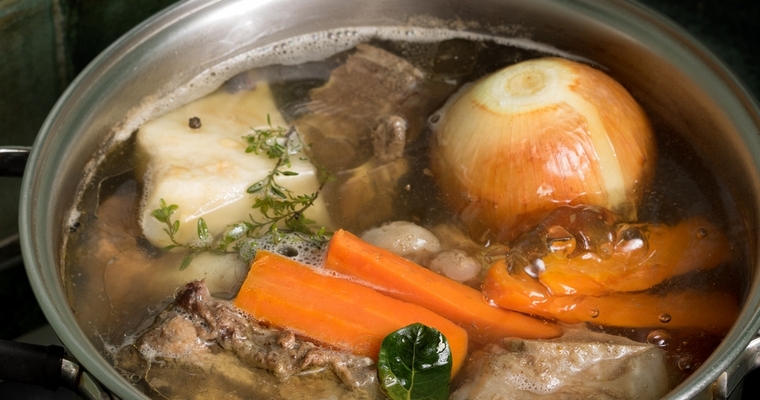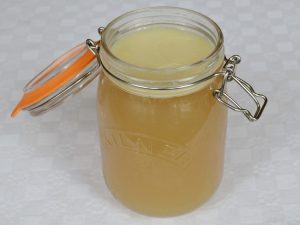Guide to making nourishing and flavoursome stock from animal bones. Explains what you do, how to store it, and recipes for fish, chicken and red meat stock.
Technique
01. What is stock?
02. Why make stock?
03. How long does it take to make stock?
04. How long does stock keep, and how do I store it?
05. What ingredients do I need to make stock?
06. Where can I get the animal bones to make stock with?
07. Can I use the same method for all animal bones stocks?
08. Why do I need to skim stock?
09. Can I make vegetarian stock?
Recipes
10. Chicken Stock
11. Lamb, Beef or Veal Stock
12. Fish Stock
13. Vegetable Stock
14. What dishes can I use stock in?
01. What is stock?
Stock is a richly flavoured cooking liquid that is made by simmering animal bones in water over a low heat for several hours, usually with aromatic vegetables and herbs. The long cooking process draws out the minerals from the bones, and converts the collagen contained in the connective tissue into gelatin. This creates a thick sauce, that has a jelly-like consistency when cooled, and that can be used as a cooking sauce or braising liquid.
02. Why make stock?
The benefits of making your own stock are threefold. First and foremost, stock is extremely nutritious, packed with essential minerals such as calcium and magnesium. In addition, gelatin is hydrophilic – that is, it attracts water. This means that when gelatin is consumed as part of a meal it attracts digestive juices, and so aids digestion. Secondly, stock is packed full of flavour, and provides the essential base flavour for hundreds of dishes such as soups, stews, curries, risottos, gravies and sauces. Thirdly, it is an economical way of getting as much out of the animal as possible, by stretching out leftovers for another meal, rather than discarding as scraps.
03. How long does it take to make stock?
A properly prepared meat stock needs 4 – 6 hours of slow cooking to draw out the minerals and gelatin from the bone. It is very easy to tell whether you have achieved this, as the stock should have a thick, jelly-like consistency after it has been left to cool overnight in the fridge. However, making stock is not an onerous task. The preparation time is minimal and, once you get it going, you can just leave it to simmer gently by itself, with no further intervention required.
04. How long does stock keep, and how do I store it?
Stock can be kept for several months if frozen, or for about five days if chilled in the refridgerator. After several hours chilling, when the stock has completely cooled and set, the fat will rise to the top and congeal to form a solid white layer on the top. This layer helps preserve the stock, but needs to be removed before you use the stock. Use a metal spoon to carefully scoop off the fat. Don’t throw the fat away, as you can keep it for cooking with. Generally you should match the rendered animal fat to the meat you are cooking, as the fat will taste strongly of the animal it came from. For example, if you made a beef stock, then next time you roast a beef joint you can use the rendered beef fat to baste the joint.
You can extend the shelf-life of refridgerated stock for another few days by reboiling it. If you are short on space, you can create a concentrated stock by boiling down the stock for several hours until reduced. You can then store this ‘demi-glaze’ reduction in ice cube trays, and simply mix with water when ready to use to create a stock.
05. What ingredients do I need to make stock?
A good basic stock will contain animal products (meat, bones or giblets), aromatic vegetables (onion, garlic, carrots and celery), herbs (parsley, bay leaves and 8 or so whole black peppercorns) and water. But to some degree it all depends on what trimmings you have to hand, and what would otherwise be consigned to the compost heap. By this I don’t mean that you should throw in spoiled vegetables, but rather that it is worth reserving the odd ends and stalks that are a by-product of cooking, rather than throwing them away. Keep these in a container in the fridge for when you are ready to make a batch of stock. In the same way, you can keep a bag of bones in the freezer, which you can keep adding to every time you cook meat on the bone or whole fish, until you have enough bones to make a stock.
You don’t need to add salt to stock, as this will interfere with the seasoning in your final dish. Starchy vegetables such as parsnips, potatoes and artichokes should also be avoided, as these will make the stock cloudy. You can add onion skins if you want to impart some colour to the stock, but avoid beetroot and very green vegetables for the same reason. Just keep in mind that if you stick to milder-tasting vegetables and herbs then you will produce a more versatile stock. Adding strong flavours to your stock will limit the dishes it can be used in.
06. Where can I get the animal bones to make stock with?
Besides saving the bones from your cooking, you can ask any good butcher or fishmonger for bones and they will usually throw them in for free (provided you are a good customer in turn!). It is worth telling them that you want to use them for stock, as they will give you the most suitable bones, and crack them for you to give access to the bone marrow.
07. Can I use the same method for all animal bones stocks?
Broadly speaking, there are three methods for making stock, depending on whether you are making stock out of the bones of fish, white meat such as chicken, or red meat such as beef, lamb and game. Fish stock only needs to be simmered for 25 minutes, as longer cooking destroys the flavour and results in a bitter-tasting stock. This is because fish do not have weight-bearing muscles, so the connective tissue in fish is much more delicate than the connective tissue in mammals, and breaks down much more quickly. White meat stock, on the other hand, needs to be simmered for several hours. Red meat and game bones, meanwhile, first need to be browned by roasting in a hot over for 45 – 60 minutes, before they are ready to go into the stock pot. This extra step gives a richer flavour and a darker colour to the stock.
You cannot make stock out of pork as it is too greasy, and does not impart enough flavour to make the exercise worthwhile. Likewise, oily fish such as salmon, mackerel and trout are unsuitable.
08. Why do I need to skim stock?
It is important to bring the stock to the boil, rather then cutting corners by tipping in just-boiled water from the kettle. This is because very hot water will seal the collagen into the bones, and prevent it from being released into the stock. As the water reaches the boil, a scummy foam will form on the surface. This is caused by denatured proteins rising to the top, and is flavourless and harmless. However, most people skim off these impurities to prevent the proteins from dispersing back into the liquid and creating a cloudy stock. There is a certain knack to this, and I find the best way is to use a ladle. Lower a ladle over the centre of the pan, until the bottom just breaks the surface of the stock. Sweep the ladle around in a circle, gradually increase the circle to push the foam to the sides of the pan. Then scoop up the foam from the sides and discard.
09. Can I make vegetarian stock?
You can make a flavoursome stock from vegetables and aromatics alone. Vegetarian stock is not as rich as stock made from
animal parts, and the consistency will remain thin due to the absence of gelatin. This also means that vegetable-based stocks are much quicker to make, as they don’t need hours of gentle simmering to draw out the minerals from the bones. And you don’t need to skim them, because there are no proteins to create an undesirable layer of scummy foam. However, you do need to replace the umami flavour that comes from meat. Umami is one of the five basic tastes, together with bitter, salty, sour and sweet. It is usually described as ‘meaty’ or ‘savoury’. It is found in fresh foods like black olives, mushrooms, tomatoes, seaweed, anchovies and hung meat, and in aged and fermented foods like balsamic vinegar, miso, nutritional yeast, soy sauce, blue cheese, parmesan cheese, fish sauce and cured meats. This is why vegetarian stocks usually contain mushrooms or tomatoes.
10. Chicken Stock
Ingredients
- Chicken carcass, leftover from roast dinner
- Chicken neck and gizzards (if available)
- 1 tablespoon cooking oil (I used lard)
- 1 carrot, peeled and diced
- 1 celery stick, sliced
- 1 onion, peeled and diced
- 2 garlic cloves, peeled and cut in half lengthways
- 2 bay leaves
- 8 whole peppercorns
- 4.5 pints (2.5 litres) cold water
to add for the final 10 minutes:
- small bunch of parsley
Instructions
- In the largest pan you own, heat the cooking oil over a medium heat. Add the carrot, celery, onion and garlic and sweat for 5 minutes. Meanwhile, break down the chicken carcass with your hands by pulling apart the rib cage (this will help impart the collagen into the stock, ensure the bones remain submerged during cooking, and make it easier to skim the stock). Add the chicken carcass, neck and gizzard and sweat for 5 minutes. Add the bay leaves, peppercorns and water.
- Turn the heat up to high and bring to the boil. This will cause the impurities to rise to the top, creating a layer of foam. Stand over the stock for the next 5 minutes or so, skimming off the foam with a ladle until no more foam appears.
- Reduce the heat to a very gentle simmer, with just the odd bubble breaking to the surface. Leave to cook for at least 4 – 6 hours – as long as you can. Add the parsley for the final 10 minutes.
- When finished, drain the stock through a colander placed over a bowl to remove the bones and vegetables. Then pour the stock through a fine sieve placed over your storage container. Leave to cool to before refrigerating – within 2 hours. If it is not possible to wait for the stock cool, then run a sink of cold water and sit the container in the sink to bring down the temperature quickly.
11. Lamb, Beef or Veal Stock
Ingredients
- 500g – 1 kg bones and trimmings
- 1 onion, peeled and quartered
- 2 garlic cloves, peeled and cut in half lengthways
- 1 tablespoon cooking oil, melted (I used lard)
- 1 carrot, peeled and diced
- 1 celery stick, sliced
- 2 bay leaves
- 8 whole peppercorns
- 4.5 pints (2.5 litres) cold water
to add for the final 10 minutes:
- small bunch of parsley
Instructions
- Preheat the oven to 200°C/400°F. Place the bones, onion and garlic in a large roasting tray. Add the cooking oil and toss until evenly coated. Cook for 45 minutes, turning halfway through. The bones should be browned, but not burnt, as this will impart a bitter taste into the stock.
- Transfer the bones, onion and garlic to the largest pan you own. Scrape off the browned bits from the bottom of the roasting tray, and add these to the pan. Add the carrot, celery bay leaves, peppercorns and water.
- Put the pan over a high heat and bring to the boil. This will cause the impurities to rise to the top, creating a layer of foam. Stand over the stock for the next 5 minutes or so, skimming off the foam with a ladle until no more foam appears.
- Reduce the heat to a very gentle simmer, with just the odd bubble breaking to the surface. Leave to cook for at least 4 – 6 hours – as long as you can. Add the parsley for the final 10 minutes.
- When finished, drain the stock through a colander placed over a bowl to remove the bones and vegetables. Then pour the stock through a fine sieve placed over your storage container. Leave to cool before refrigerating – within 2 hours. If it is not possible to wait for the stock cool, then run a sink of cold water and sit the container in the sink to bring down the temperature quickly.
12. Fish Stock
Ingredients
- 500g – 1kg fish bones and trimmings (do not use oily fish like mackerel)
- 1 tablespoon cooking oil (I used lard)
- 1 carrot, peeled and diced
- 1 celery stick, sliced
- 1 onion, peeled and diced
- fennel bulb trimmings, chopped
- 2 bay leaves
- 8 whole peppercorns
- 2.25 pints (1.25 litres) cold water
to add for the final 10 minutes:
- small bunch of parsley
Instructions
- In the largest pan you own, heat the cooking oil over a medium heat. Add the carrot, celery, onion and fennel and sweat for 5 minutes. Add the fish bones and sweat for 2 minutes. Add the bay leaves, peppercorns and water.
- Turn the heat up to high and bring to the boil. This will cause the impurities to rise to the top, creating a layer of foam. Stand over the stock for the next 5 minutes or so, skimming off the foam with a ladle until no more foam appears.
- Reduce the heat to a very gentle simmer, with just the odd bubble breaking to the surface. Leave to cook for 25 minutes only. Add the parsley for the final 10 minutes.
- When finished, drain the stock through a colander placed over a bowl to remove the bones and vegetables. Then pour the stock through a fine sieve placed over your storage container. Leave to cool to before refrigerating – within 2 hours. If it is not possible to wait for the stock cool, then run a sink of cold water and sit the container in the sink to bring down the temperature quickly.
13. Vegetable Stock
Ingredients
- 2 tablespoons cooking oil (I used olive oil)
- 1 onion, peeled and quartered
- 2 carrots, peeled and diced
- 2 celery sticks, sliced
- 2 garlic cloves, peeled and cut in half lengthways
- 100g mushrooms, sliced (chestnut and portobello have the best flavour)
- fennel bulb / leek trimmings, chopped (optional, if you have them)
- 2 bay leaves
- 8 whole peppercorns
- 1.75 pints (900ml) cold water
to add for the final 10 minutes:
- small bunch of parsley
Instructions
- In the largest pan you own, heat the cooking oil over a medium heat. Add the carrot, celery, onion and garlic and sweat for 5 minutes.
- Add the mushrooms, fennel trimmings (if you have them), bay leaves, peppercorns and water. Reduce the heat to a steady simmer. Leave to cook for 25 minutes, adding the parsley for the final 10 minutes.
- When finished, drain the stock through a colander placed over a bowl to remove the vegetables. Then pour the stock through a fine sieve placed over your storage container. Leave to cool to before refrigerating – within 2 hours. If it is not possible to wait for the stock cool, then run a sink of cold water and sit the container in the sink to bring down the temperature quickly.
14. What dishes can I use stock in?
Chicken Stock:
Fish Stock:
Lamb, Beef & Veal Stock:
Vegetable Stock:

















